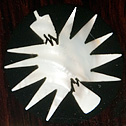| |
Interview with Howard Kramer, Curatorial Director of The Rock and Roll Hall of Fame and Museum by Steve Armato
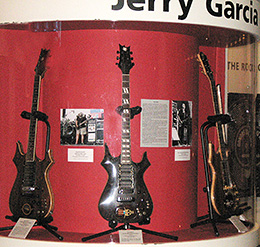
Photograph Courtesy of the Rock and Roll Hall of Fame and Museum, Cleveland, OH
Armato: How did the Rock Hall of Fame acquire the exhibit for Jerry Garcia’s guitars?
Kramer: I got a call from Grateful Dead Productions in February 2001. They had a number of Jerry’s guitars - a total of six of them. They were willing to loan us five of them, indefinitely. At the time they were just sitting in a warehouse, and they felt that was wrong. They thought the guitars should be in a place where their fans could appreciate them.
Armato: How long did it the process take to complete?
Kramer: The process didn’t take very long. We sent them our loan agreement and negotiated the terms, which was easy. Our loan agreements are pretty basic and they were fine with them.
They did have one condition. The guitars had to be in a place where people could see them without having to pay. The museum is a not-for-profit organization, so we live off admissions. We had to come up with a method of exhibiting the guitars in a location where it didn’t cost people an admission fee to see them. That was a challenge.
Our exhibits department came up with the idea of creating cases that wrap around the support columns in the lobby on our lower level, just outside the main exhibit hall. That was the genesis of making it happen. We created these cases in a common area. Now, anyone can come in, take a look at them, and turn around and leave, if they want. They don’t have to pay admission to see them. That is how we satisfied that condition and Grateful Dead Productions was happy with that arrangement. The exhibit was completed in the spring of 2001.
The concept has expanded to other artists’ instruments, as well.
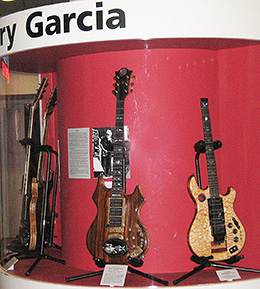
Photograph Courtesy of the Rock and Roll Hall of Fame and Museum, Cleveland, OH
Armato: It sounds like it’s a good way to entice people to come in and see the rest of the exhibits.
Kramer: I think it’s a great start. People who understand guitars, look at the instruments and know, ‘this is heavyweight, SERIOUS stuff.’ If you are a fan of the artist, you are going to recognize a number of these pieces as the real deal. It’s a teaser to set the tempo of what people are going to see in the rest of the museum.
|
 |
Armato: How many people visit the Rock Hall of Fame each year?
Kramer: We have roughly half a million visitors go through each year and virtually everybody has to pass by where the Jerry Garcia guitars are exhibited.
Armato: What is the overall reaction to that exhibit?
Kramer: I can’t gauge every exhibit, but I know, from watching people come in the museum, that they immediately stop and take a look. For the casual fan, it’s striking to see the instruments, because they are all beautiful. The four guitars that we have are stunning. For the Grateful Dead fan, it’s revelatory. There are many Dead fans that make a point of stopping here just to see the guitars. Another thing about the way they are exhibited is, you can get very close to them. They are behind the Plexiglas, but you are literally inches away from them. You get a great feeling off these things, the beauty of them.
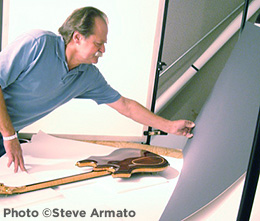
Photographer Carl Fowler ridding Rosebud of shadows during the Garcia guitar photo shoot.
Armato: Have any members of the Grateful Dead seen the exhibit?
Kramer: Yes. Let’s see, Bob Weir has seen it. I took Mickey Hart through the museum. I assume Bill Kreutzmann must have seen it, but I was not here when Bill visited. Actually, Phil Lesh has been here too. The four guys have seen them. All four have been here.
Armato: Any other comments?
Kramer: I want to go back on one thing. We started out with five guitars and now we have four. That’s because of Irwin’s lawsuit and subsequent auctioning off of Tiger and Wolf.
Armato: I’m sure you were sad to see Tiger go.
Kramer: I was, but I wasn’t surprised. When the instruments were first loaned to us, Irwin’s legal issues were brewing. The Dead held back a guitar on purpose.
Armato: That being Wolf.
Kramer: Right, I never saw Wolf. The other thing, for our purposes, we could only put five guitars out anyway. Grateful Dead Productions made a point to leave one out, for whatever reasons. They obviously had a good reason to do so. We were fine with any rationale they had. It wasn’t our concern so much. Were we sad to see Tiger go? Absolutely. But, we still have a great exhibit!
Armato: I’ve enjoyed it. Thank you.
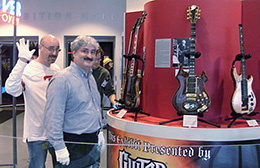
Howard Kramer and Steve Armato watching the exhibit being reassembled. Photo courtesy of Joe Sligh. |
